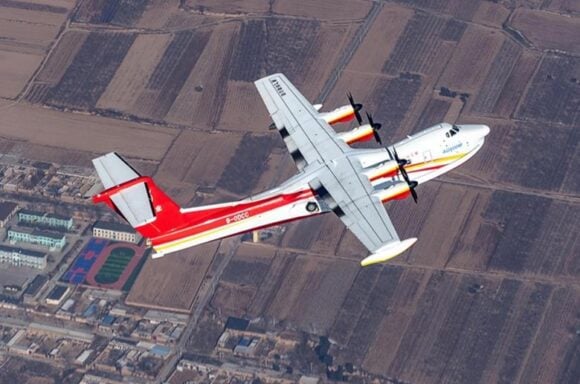China is a nation that is increasingly flexing its muscles, and it has muscles to flex. The nation’s wealth is rising and with this all manner of new economic activities are coming to the fore. Without doubt one of the most influential is travel. China’s insular behavior is evolving into exactly the opposite. China is combing the globe for natural resources, like oil, notably in Africa. This means China is engaging with the world at a growing pace.
Moving a growing number of Chinese around the world means building Chinese airlines. To support this growth China has decided to develop its own aerospace industry. Dual use technologies in aerospace are attractive because besides commercial aviation, China has ambitious military aerospace goals. China has spent years buying foreign aircraft, taken them apart, and learned what makes them work. To date, the primary abused party has been Russia. Increasingly though, China is forging ahead on its own – which means paying for its own research and development.
Perhaps the start of serious Chinese commercial aviation ambition can be traced to the Shanghai Y-10 seen here.  This unfortunate looking aircraft was a copy of the Boeing 707. Apparently only two were built before the program was scrapped. Built in the 1970s, the plane flew in 1980. There is an important lesson here – China’s main competitive asset is not billions in national reserves or its huge population – it is patience. China takes a long term view that is virtually incomprehensible to western thinking. If a five year plan is seen as silly to western minds, it is seen as short term by China.
This unfortunate looking aircraft was a copy of the Boeing 707. Apparently only two were built before the program was scrapped. Built in the 1970s, the plane flew in 1980. There is an important lesson here – China’s main competitive asset is not billions in national reserves or its huge population – it is patience. China takes a long term view that is virtually incomprehensible to western thinking. If a five year plan is seen as silly to western minds, it is seen as short term by China.
This fundamental difference in thinking is important to keep in the back of the mind as we review China’s aerospace ambition. China keeps (relentlessly) at its goals. Setbacks are learning opportunities. There are no shareholder worries – the big picture remains front and center and progress is all that matters. Profits are nice, but not critical for China’s aerospace industry, yet.
For an excellent background on the emergence of China’s aerospace development, we recommend you read this. The amazing pattern one can see is that China has successfully exploited western aerospace firms time and again. When it was clear China could not master its own aerospace development, it decided to bring in partners. Using a well thought out approach always in favor of China, these partners had to build plants in China and use Chinese labor. The line of firms working in China includes all the big commercial aerospace names – McDonnell Douglas, Embraer, Airbus and Boeing. Add to this numerous aerospace component manufacturers as well. Each wave has added to China’s IP at low risk for the host nation – western firms have been teaching and training their future competitor. Long term patience trumps short term greed every time.
China has had a tougher time developing its own aero-engines. But take enough of them apart and you get the idea of how to make them. China’s aerospace ambitions are not unusual. The nation leaped over telecom development hurdles by avoiding massive land line network costs by going straight for latest generation cellular technology. China has been playing catch up in all sorts of technologies. It’s not just telecoms – China is chasing automobiles too. The massive trade imbalance between the USA and China is testimony to China’s prowess at making the things Americans and others are prepared to go into debt for.
With its wealthy central bank backing, China is embarking on a new strategy – it buys what it wants. Recently China bought Continental Motors, makers of piston aero-engines. The acquiring party was AVIC, China’s leading aerospace firm. Almost certainly there is more to come.
China now has two important commercial aerospace projects; the ARJ21 and the C919. The former looks very much an updated McDonnell Douglas DC9 and the latter like a tweaked A320. Aerospace analysts are not surprised – copying designs has been the preferred Chinese method so far. The ARJ appears to be way heavier than it should be and is only likely to be sold to Chinese airlines. Sold being a euphemistic way of describing it; cajole may be closer to the truth. GE, as engine provider on the ARJ, ordered a handful and it will be very interesting to see where these airplanes end up on lease.
The C919 is already a technical improvement on the ARJ21 and may have relatively better payload performance. It will have much more modern engines (GE’s LEAP-X). Of course designing a hull is much easier than integrating all the innards under the skin. Modern aircraft are highly complex machines and the computers and associated wiring is not as easy to copy. We understand that Chinese fingers have been caught at least three times trying to break into Airbus’ computer network at its Tianjian factory. Airbus won’t talk about it and of course the Chinese say nothing. But it makes sense that China wants to understand what technologies work at keeping modern airliners aloft. They have already managed to develop similar technologies – the Chinese J-11 fighter looks remarkably like the Sukhoi SU-27. You can see why non-Chinese aerospace firms need to tread warily in China. The Chinese have exhibited a regular pattern of, to be polite, being liberal in their understanding of and respect for others’ IP. Software firms like Microsoft and the Hollywood studios have some experience with this “problem”.
In summary, China will almost certainly manage to achieve its goal of becoming an aerospace power. China is likely to continue “acquiring” western IP. Its commercial projects will initially be “sold” to Chinese airlines – who will almost certainly put unrelenting pressure on AVIC and COMAC to improve performance to match that of western aircraft. Any performance shortfalls will likely be made up through lower prices on aircraft they would rather buy.
Again the over riding issue here is Chinese patience. Whereas the Chinese airlines may have to compete with foreign competition and demand appropriate performance, Chinese aerospace companies can afford to discount prices to get the business and jump on a steep learning curve. There is simply enough money at the central bank to make this work. If it takes five years or ten years or more – time is not the main concern. China is confident it will continue to export more than it imports and therefore have funding for a voracious capital appetite within its growing aerospace industry.
By the way China’s high speed railway is an excellent example of how the state has managed to fund technical progress effectively so that China now has the world’s largest high speed rail system and its technology is available for export. Based on price terms, who do you think can beat them? In terms of technology they are about equal to any other rail system competitor.
And so it will go with China’s aerospace program. With enough patience and money they can do anything. Too bad the West has too little patience and spends too much on consumption.
Views: 6




The Chinese are relentless, but not 10 feet tall. Substitute “Japan” for “China” in much of the above article and it could read like a one of those ominous articles from the 1980s. For that matter, is the Chinese J-20 a “super stealth fighter” or MiG-25 revisited?
Fair point
Japan copied the western model wholesale.
china is capitalism controlled and directed by the communist party.
Most democracies (today) are controlled by shortsighted greed.
Especially in the US domain this greed works inside a contracting scope. No longer is it productive. Redistribution or plain gutting of
resources feeds todays rich while downgrading the middle class.